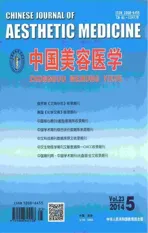关于正畸微种植钉在前牙植入位点的系统评价
2014-04-29陈桂玲艾毅龙余兴华孙德文
陈桂玲 艾毅龙 余兴华 孙德文
[摘要]目的:通过采用CT或CBCT评估硬组织如牙槽骨厚度、骨深度、骨密度的参数,系统评价正畸种植钉在前牙区的植入位点。方法:检索CENTRAL, MEDLINE, EMBASE, 和CNKI共4个数据库。检索日期截止2013年3月1日。检索主题词为“CT”、“种植钉”。筛选符合纳入条件的植入区域“上颌前牙颊侧区域、上颌前牙腭侧区域、下颌前牙颊侧区域”。不同文章中的计量资料将用评分系统来定性。结果:检索到的831篇文献中,8篇符合笔者的纳入标准。正畸微种植钉在前牙的最适合植入位点是尖牙与第一前磨牙之间;最适替代区域是侧切牙与尖牙之间,在上颌腭侧区域则是中切牙间或侧切牙与尖牙之间。结论:虽然不同研究间异质性较大,但对于采用CT或是CBCT来评估前牙区理想植入位点,其不同的解剖学参数却共性很高。侧切牙与第一前磨牙间的区域是最适的前牙区植入位点,但根间距这一关键因素作为影响种植钉植入因素仍需学界进一步研究及评估。
[关键词]CT;种植钉;植入位点
[中图分类号]R783.5 [文献标识码]A [文章编号]1008-6455(2014)05-0389-06
The systematic review to the insertion site of the mini-implant in the anterior alveolar region
CHEN Gui-ling1,AI Yi-Long1,YU Xing-hua1,SUN De-wen2
(1.Department of Orthodontics,Affiliated Stomatological Hospital,Foshan University,Foshan 528000,Guangdong,China;2.Collegeofmedicine,Foshan University)
Abstract: ObjectiveTo perform a systematic review regard the adequacy of potential sites for insertion of orthodontic mini-implants (OMIs) in the anterior alveolar region which used CT or CBCT toinvestigate the anatomical hard tissue parameters, such as available space, bone thickness and bone density. MethodsCENTRAL, MEDLINE, EMBASE, and CNKI were searched to identify all relevant papers published between 1980 and March 2013. An extensive search strategy was performed that included the key words "computerized (computed) tomography" and "mini-implants." Information was extracted from the eligible articles for three anatomical areas: maxillary anterior buccal, maxillary anterior palatal, and mandibular anterior buccal. Quantitative data obtained for each anatomical variable under study were evaluated qualitatively with a scoring system. ResultsEight studies met our inclusion criteria of the 831 articles identified by the search. The most favorable area for OMI insertion in the anterior maxilla (buccally and palatally) and mandible was between the canine and the first premolar.The best alternative area in the maxilla (buccally) and the mandible was between the lateral incisor and the canine, while in the maxillary palatal area it was between the central incisors or between the lateral incisor and the canine. ConclusionThere is a good level of agreement regarding the optimal site for OMI placement in the anterior region among investigations of anatomical hard tissue parameters based on CT or CBCT scans although considerable heterogeneity among studies exist. In this context,the area between the lateral incisor and the first premolar is the most favorable.However,interroot distance seems to be a critical factor that should be evaluated carefully.
Key words:computed tomography;mini-implants;sites for insertion正畸中的支抗控制可以说是治疗的关键,传统加强支抗的办法常需要患者要有较好的依从性,而且要花费额外时间制作装置;随着不同种类的骨支抗装置特别是正畸微种植钉的出现及应用,克服了以往的不足,它能在三维方向上起到绝对支抗的效果[1], 给正畸理念带了巨大的革命。
微种植钉的植入受多种因素影响:植入位点几何方向的选择、植入位点的物理化学因素以及患者自身牙槽骨的情况。其中患者自身的牙槽骨的一些参数(如牙槽骨的厚薄、根尖的距离以及牙槽骨密度)对微种植钉的植入影响更大[2-3]。较传统的头颅侧位片及全景片,通过CT或是CBCT来评估这些参数更为合适,因为它们能够提供三维方向上的数据[4]。本篇系统评价也是为了从这些参数中探讨植入微种植钉的安全性和有效性。
之前有很多学者提出了最理想的和最适合替代的植入位点,但缺乏用于指导临床操作的系统评价。AlSamak S等学者制作的系统评价5指出在上下颌最适植入区域是第二前磨牙到第二磨牙区的颊腭侧,该植入区域是从前后牙整体上讨论而没有细致划分为前牙区或是后牙区,因此得出的结论也是偏向于后牙区为最佳位点,而对前牙区缺乏进一步的关注。下颌前牙很少有微种植钉种植,一方面是因为根间距,另一方面是容易对下颌舌侧造成过多的刺激和干扰,因此很多病例的植入位点常选在上颌前牙区域。因此我们的目标就是制作一个关于前牙区最适种植位点的系统评价,以方便临床操作。
1材料和方法
1.1文献来源:检索方式采用计算机检索,检索资料库包括:Cochrane Central Register of Controlled Trials (CENTRAL)、MEDLINE、EMBASE及 CNKI(中国学术期刊全文数据库)4个数据库。检索无语言限制,检索1980年~2013年3月间的文献。中文检索词包括:主题词为“CT”、“种植钉”。英文主题词:“mini-implants”、“CT”,根据不同资料库的特征分别进行主题词联合自由词、关键词,篇名联合全文进行综合检索。病例及个案报道、综述、及动物实验的文章将被排除在外。
1.2 数据提取:符合纳入标准文献的信息根据以下3个解剖学区域分类:①上颌前牙颊侧牙槽骨区;②上颌前牙腭侧牙槽骨区;③下颌前牙颊侧牙槽骨区。通读所有的文章后,获取不同的解剖学参数等信息,将不同文章中涉及到最适位点和最适替代位点的数据分别提取出来并各自汇总。有最高得分和第二高得分的分别被认定为最适位点和最适替代位点。
1.3关于方法学的考虑:关于颊舌侧骨深度的测量是对颊腭侧牙槽骨评估后打分得到的,而且必须对两侧(颊侧和舌、腭侧)进行评估,如果只进行单侧测量会引起较大偏差,例如有些多根的第一前磨牙只测量一侧数值是不够,纳入此篇系统评价的文献均是从双侧进行测量的。
因为方法学的差异性(见讨论部分),进行定量的Meta分析合并并不实际,因此放弃Meta分析而进行定性描述。评估出每组参数得分最高和第二高,而后进行归类描述。
2结果
2.1 文献的纳入:在MEDLINE上检索到的407篇文献中,通过阅读标题排除了320篇,通过阅读摘要又排除了55篇,有24篇文章通过阅读全文后排除因为它们都只评估了一个植入区域或者是与我们需要的前牙区不相关(腭部n=9;后牙牙槽区域n=7;颧骨下区域n=2;上颌第二前磨牙到第一磨牙区域n=2;尖牙到第二磨牙区域n=3;侧切牙到尖牙以及第二前磨牙到第一磨牙n=1),其余8篇文献符合纳入标准。
在EMBASE数据库检索到436篇文献。117篇因为与MEDLINE检索到的文献重复而排出掉,剩余319篇文献中通过阅读题目和摘要排除309篇,其余10篇通过阅读全文被排除掉(颧骨下方区域n=1,不相关区域n=9)。Cochran系统评价数据库共检索到24篇文献,均因题目不相关被排除。CNKI数据库检索到10篇文献,均因与题目不相关被排除。纳入此篇系统评价的文献[6-13]以及对具体数据的评估分别罗列在表1和表2中。所有纳入的研究均无严重咬合问题。
2.2参数测量及组间一致性:硬组织参数选用最多的是根间距,接下来是皮质骨厚度、骨深度和骨密度。
上下颌颊侧皮质骨厚度的测量及下颌颊侧区域的骨深度、根间距测量的一致性较好;上颌根间距获得了中度一致性;上颌骨深度在最适植入区域测量的一致性也是较好;而骨密度没有出现在任何一篇文献中。干枯头颅上的数据与活体研究在数据上的一致性较高(见表3)。
2.3正畸微种植钉前牙区理想植入位点:在上、下颌颊侧的最适植入区域是尖牙与第一前磨牙间的区域;最适替代区域是侧切牙与尖牙之间,而上颌腭侧最适替代区域是中切牙之间或侧切牙与尖牙之间,但因为中切牙在解剖学上的局限,也可考虑为上颌腭侧最佳替代区域为侧切牙与尖牙之间(见表3~4)。
3讨论
3.1 材料的选择:CT和CBCT在评估硬组织参数如骨深度、皮质骨厚度、根间距和骨密度上有高度的准确性和可靠性,特别是与传统二维的测量方法比较[14]。CT在软组织成像上较CBCT有优势,但CBCT放射剂量低、价廉并可在三维方向上提供硬组织参数且不会引起较大的影像扭曲和失真。
多数纳入的文献都在垂直方向上进行多层次的测量。目前测量垂直方向的参照有两个:牙槽嵴和釉牙骨质界。通常釉牙骨质界在牙槽嵴牙合方1.0mm,这并不会给我们的结果造成影响,因为我们将原始计量数据转化为定性资料。
采用干枯头颅研究的这篇文献被纳入系统评价,并给与了其与活体研究相同的权重,是因为之前有研究评估过正畸微种植钉在整个牙槽区域植入时,干枯头颅上的研究与活体研究并无任何统计学差异,和我们的研究结果一致。性别和年龄的不示,下颌平均骨皮质厚度在最适植入区域和最佳替代区域的跨度分别为1.1~2.7mm及1.0~2.4mm;在上颌颊侧,平均骨皮质厚度在最适植入区域和最佳替代区域的跨度分别为1.1~2.6mm及0.9~2.6mm;在上颌腭侧,平均骨皮质厚度在最适植入区域和最佳替代区域的跨度均为1.7mm。 因此多数情况下这个条件在前牙区都能得到满足。
4结论
尽管不同研究间存在较大异质性,在正畸微种植钉前牙区最适植入区域和最佳替代区域的选择上各个研究的一致性较高。
在前牙区植入正畸微种植钉需要多参考解剖学参数如皮质骨厚度、骨深度、骨密度及根尖距,尤其是根尖距在前牙区种植支抗设计时需要慎重。我们的系统评价也得出根尖距在纳入的所有文献中一致性只达到中等水平,而其他几项数据不同研究间的一致性却很高。
[参考文献]
[1]Papadopoulos MA,Papageorgiou SN,Zogakis IP.Clinical effective-ness of orthodontic miniscrew implants: A meta-analysis[J].J Dent Res,2011,90:969-976.
[2]San tiago RC, de Paula FO, Fraga MR, PicorelliAssis NM, Vitral RW. Correlation between miniscrew stability and bone mineral density in orthodontic patients[J].Am J Orthod Dentofacial Orthop,2009,36:243-250.
[3]Motoyoshi M,Yoshida T,Ono A,et al.Effect of cortical bone thickness and implant placement torque on stability of orthodontic mini-implants[J].Int J Oral Maxillofac Implants,2007,22:779-784.
[4]Kau CH,Bozic M,English J,et al.Cone-beam computed tomography of the maxillofacial region-An update[J].Int J Med Robot,2009,5:366-380.
[5]AlSamak S,Gkantidis N,Bitsanis E,et al.Assessment of poten-tial orthodontic mini implant insertion sites based on anatomical hard-tissue parameters: A systematic review[J].Int J Oral Maxillofac Implants 2012;27:875-887.
[6]Hernández LC, Montoto G, Puente Rodríguez M,et al. 'Bone map' for a safe placement of miniscrews generated by computed tomography[J].Clin Oral Implants Res,2008,19:576-581.
[7]Lim JE, Lim WH, Chun YS.Quantitative evaluation of cortical bone thickness and root proximity at maxillary interradicular sites for orthodontic mini-implant placement[J].Clin Anat,2008,21:486-491.
[8]Cho i JH, Park CH, Yi SW, Lim HJ,et al.Bone density mea-surement in interdental areas with simulated placement of orthodontic miniscrew implants[J].Am J Orthod Dentofacial Orthop, 2009,136:76 6,e1-e12.
[9]Chun YS,Lim WH.Bone density at interradicular sites:Implications for orthodontic mini-implant placement[J].Orthod Craniofac Res,2009,12:25-32.
[10]Lee KJ,Joo E,Kim KD,et al.Computed tomographic analysis of tooth-bearing alveolar bone for orthodontic miniscrew placement[J].Am J Orthod Dentofacial Orthop,2009,135:486-494.
[11]Lim JE, Lee SJ, Kim YJ,et al.Comparison of cortical bone thickness and root proximity at maxillary and mandibular interradicular sites for orthodontic mini-implant placement[J].Orthod Craniofac Res,2009,12:299-304.
[12]Fayed MM, Pazera P, Katsaros C.Optimal sites for orthodontic mini-implant placement assessed by cone beam computed tomography[J].Angle Or thod,2010,80:939 -951.
[13]Baumgaertel S, Hans MG.Buccal cortical bone thickness for mini-implant placement[J].Am J Orthod Dentofacial Orthop,2009,136:230-235.
[14]Kapila S,Conley RS,Harrell WE Jr.The current status of cone beam computed tomography imaging in orthodontics[J].DentomaxillofacRadiol,2011,40:24-34.
[15]Maino BG,Mura P,Bednar J.Miniscrew implants: The Spider Screw anchorage system[J]. SeminOrthod,2005,11:40-46.
[16]Kim SH,Kang SM,Choi YS,et al.Cone-beam computed tomography evaluation of mini-implants after placement:Is root proximity a major risk factor for failure[J].Am J Orthod Dentofacial Orthop,2010,138:264-276.
[17]Crismani AG,Bertl MH,Celar AG,et al.Minis-crews in orthodontic treatment: Review and analysis of published clinical trials[J].Am J Orthod Dentofacial Orthop,2010,137:108-113.
[18]Cha tzigianni A,Keilig L,Reimann S,et al.Effect of mini-implant length and diameter on primary stability under load-ing with two force levels[J].Eur J Orthod,2011,33:381-387.
[19]Lemieux G,Hart A,Cheretakis C,et al.Computed tomographic characterization of mini-implant placement pattern and maximum anchorage force in human cadavers[J].Am J Orthod Dentofacial Orthop,2011,140:356-365.
[收稿日期]2013-12-25[修回日期]2014-02-08
编辑/何志斌
